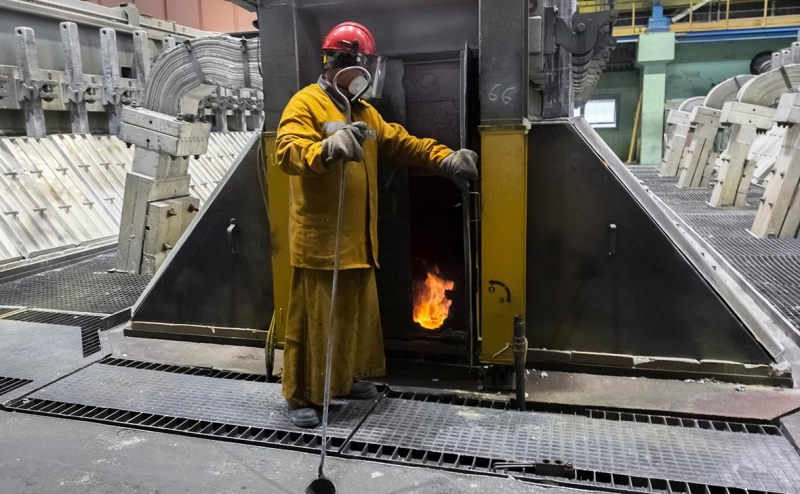Russia will be able to achieve sustainable economic growth if it develops industries taking into account their hidden advantages, the HSE estimated. So far, oil refining, metallurgy, and the tobacco industry show the highest productivity
The Russian economy has been able to adapt to the sanctions, thanks in part to natural competitive advantages such as large energy reserves and long borders with countries that have not imposed restrictions, but sustained growth in the future will require developing the hidden potential of industries. This is stated in the report of HSE experts “The Russian Economy Under Sanctions: From Adaptation to Sustainable Growth”, prepared for the XXIV Yasinsk (April) International Scientific Conference on the Development of the Economy and Society (material is available from RBC).
In addition to market incentives, it will be necessary to introduce new technologies, and this is most effective in industries with hidden comparative advantages, the authors pointed out. In the report, such industries are those with high productivity, but high transaction costs (there is a potential to reduce them and, accordingly, increase competitiveness). Such costs arise from inadequately hard (roads, equipment) and soft (legislation, government regulation) infrastructure, preventing industries from being competitive in the domestic and international markets, the report says. The most promising industries are oil refining, metallurgy, and the tobacco industry.
Most Promising Industries
The natural competitive advantages of the Russian economy—geography, wealth of natural and energy resources, and the relatively low cost of land and labor—favored its “successful transformation” against the backdrop of harsh sanctions. However, further economic growth is limited by underdeveloped infrastructure and high transaction costs, the report says.
“In order for the industrial policy of the state to support innovators and develop infrastructure to be most effective, it must, first of all, be aimed at industries that have hidden comparative advantages,” the document says. The HSE proposes to assess the prospects of industries using two indicators of labor productivity – the level of output (the ratio of output to labor costs) per employee in comparison with world standards and total factor productivity (TFP). The latter reflects an increase in efficiency due to technological progress, infrastructure development, and an increase in the quality of market and regulatory institutions.
According to the first of them – generation – three Russian industries (oil refining, metallurgy, and the tobacco industry) are among the world leaders, ranking third or fourth. However, in terms of TFP, growth rates in these industries are either negative on average for the year or only 1%, the report says. TFP is a more comprehensive indicator that reflects the contribution of capital, including investment, and labor to the increase in the output: it characterizes the contribution of organizational, technical innovations, scientific and technological progress, Valery Mironov, one of the authors of the report, deputy director of the Development Center of the National Research University Higher School of Economics, explained to RBC.
Read on RBC Pro What developments in the field of neural networks Apple is hiding How the CEO of Adidas turned the company into an outsider – The Economist Shareholders from unfriendly countries ignore meetings: what to do How to avoid unnecessary expenses and save time at the doctor’s office
Other sectors of the manufacturing industry have significantly lower production rates compared to other countries, according to HSE calculations. Among the outsiders are the production of textiles, clothing, footwear, as well as furniture, and electrical equipment.
Industrial policy accents
According to the authors of the report, it is expedient to differentiate industrial policy accents for several categories of industries and develop them in different ways. In particular:
it is important for industry leaders in terms of generation and TFP to support the research and development firms needed to maintain technological leadership;
in an industry that has lost or may lose its comparative advantages in the near future (such as the energy-intensive industry in some regions of Russia), firms should be helped either to move to more profitable sectors of global value chains, including through the development of marketing, or move production to where there are lost advantages, or change the profile;
for industries with a short innovation cycle that rely more on humans than on physical capital, emphasis should be placed on the creation of incubation parks, the promotion of venture capital, the protection of intellectual property;
for a strategically important industry with a long innovation cycle, research and development should be subsidized directly, while at the same time trying to avoid interventions that distort the market environment.
According to the scheme of HSE experts, the three leading industries in terms of productivity – tobacco, metallurgy, and oil refining – only need to maintain technological leadership, but there are questions about their potential, says Vladimir Salnikov, head of the direction of analysis and forecasting of the development of economic sectors at TsMASF.
“For example, in the tobacco industry, technological leadership is associated with tobacco heating systems. But here we just do not take any positions, this industry has traditionally been farmed out to foreign companies that placed mass low-tech production in Russia,” he says. A major player in the market is Philip Morris, whose factory is located in the Leningrad region: it, in particular, produces tobacco sticks for heating systems.
In this industry, as in metallurgy, fairly good performance indicators are associated, among other things, with low costs, primarily in wages, Salnikov suggests. “There are no serious technological advances in metallurgy; we have largely lost them. Some technologies, of course, are being introduced, but in this segment of the industry we are also shifted towards low-tech production,” the expert is categorical.
As for oil refining, this industry is based on imported technologies. “Here is the other extreme – now, due to restrictions on our exports and the need to diversify supplies, in some cases, we turn out to be even too high-tech. Due to the European embargo on Russian oil products, we have begun to reorient ourselves to third-world countries (the Middle East, Africa). There, our oil products turn out to be of too high quality and prices: they turn out to be unclaimed in these markets, given their lower solvency,” he describes.
What else is needed for sustainable growth
In general, the possibility of transition to the growth of the Russian economy in the medium term is associated with the development of production-oriented to the domestic market, HSE experts state. For sustainable domestic demand, it is necessary to preserve the size of the middle class (skilled specialists and entrepreneurs) and gradually increase its income, directed to the purchase of high-quality goods and services. In addition, attracting the resources of the middle class is also necessary for the growth of investment (based on domestic savings), HSE experts note, without giving any estimates of the size of the Russian middle class.
The limitation of the national debt market is the lack of international ratings (Moody’s, S&P, and Fitch agencies stopped working in Russia), which does not allow investors from both friendly far abroad countries and the EAEU countries to invest in Russian bonds, the authors add. In the medium term, the issue can be resolved by building cooperation between the national rating agencies of Russia and the BRICS countries and mutual recognition of the ratings of all national agencies in the BRICS space, they believe.



Comments are closed.